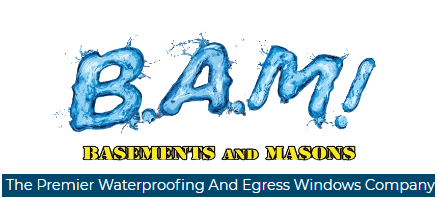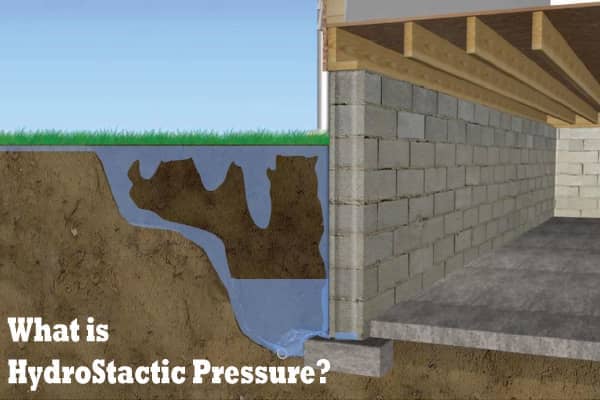What is Hydrostatic Pressure?
In regard to basement foundation problems, hydrostatic pressure can be best described as the constant force of water pressure constantly being forced on the basement walls.
As a general rule, hydrostatic pressure increases as subsurface depth decreases, due to the increasing weight of earth and gravity generating downward force from above. This is what makes basement foundations that reside beneath the earth in moist soil conditions so susceptible to foundation damage. In other words, the deeper the foundation and the wetter the soil conditions, the greater the risk for structural damage.
Is Your Basement Affected by Hydrostatic Pressure?
If your home’s foundation or basement walls are built fully or partially below the water table, or on a hillside where water runs down from above, be on the lookout for the rampaging force of nature known as hydrostatic pressure, which can cause cracks in walls, flood your basement and ultimately cause significant water-related damage.
Hydrostatic pressure describes the outward and downward pressure caused by standing water pushing against any object or surface that blocks it, in this case your basement walls. The pull of gravity against standing water is relentless, causing the water to push and push hard against anything that restricts its flow. Water is very dense, and it is capable of generating immense hydrostatic pressure when it has nowhere else to go or isn’t directed away from your home.
Hydrostatic pressure due to water hill
If a basement home sits below a hill, and is susceptible to runoff, resulting in high levels of hydrostatic pressure. Which can ultimately cause walls to crack.
Hydrostatic Pressure and its Impact on Your Foundation
Concrete foundation slabs, their connected flooring systems and the basement walls that surround them are highly vulnerable to the intrusive effects of hydrostatic pressure.
When the underground sections of a home block the natural movement of groundwater, during times of heavy runoff the soil will become saturated and foundation slabs and basement walls will suddenly become stressed by thousands of pounds of hydrostatic pressure.
If your home is well-constructed it may not crumble under the pressure, at least not for a while. But there’s something about your home’s basement walls that you might not realize, they aren’t nearly as solid and impenetrable as they appear. This is especially true of concrete used in home construction more than a decade ago, when concrete was often of a lower quality than it is today. Regardless of quality, however, when concrete dries unevenly, small, microscopic air tubes can form on the inside, and those tubes may pass all the way through the concrete from one side to the other.
Water sitting behind basement walls and foundation slabs may not bust them down or uproot them, but it will find and fill each invisible opening in the surface of the concrete it touches. This can create a series of tiny flowing veins or rivers that will ultimately seep on the other side. If this is happening in your home, the flooding of your basement may proceed at a slow pace. But it will proceed, and the longer the soil stays saturated around your home the worse your basement flooding problem will become.
Other visible signs of basement moisture problems due to hydrostatic pressure often include:
Efflorescence on basement walls or floor
Mold growth
Strange smells in the basement
Walls that bow inward or outward
Cracks in walls
visible effects of hydrostatic pressure in basement
Signs of Hydrostatic Pressure-Related Moisture Problems
Inside your basement, the signs of unwanted water penetration will be obvious. Puddles on the floor, moisture running down the walls, musty odors, mold or mildew outbreaks, insect infestation, the indicators will be unmistakable, and you’ll likely be rushing in to clean up the mess.
But how can you tell if the problem is actually caused by hydrostatic pressure? Here are some possible clues:
Your home is built on a slope, and you live in a climate where rainfall is a regular occurrence.
Your home is on a hillside and the moisture infiltration seems to begin or worsen in the spring when there has been runoff from melting snow.
You can see standing water in various areas on your lawn, suggesting high soil saturation.
If you dig a hole or trench 2-4 feet deep in your yard, the bottom soon fills with water.
The water entering your basement seems to be coming in from multiple directions and in controlled quantities.
There are no detectable cracks or openings in your concrete slab or walls.
You checked out the other possibilities and found no evidence to support them.
Neighbors with nearby homes built on the same level or to the same specification are experiencing the same problems with basement flooding as you are.
Waterproof your Basement
While leakage and flooding are the most obvious sign of hydrostatic pressure, if the problem is left unaddressed for too long it could cause consequential structural damage to your home’s foundation. If you see signs of cracking, heaving or bulging in basement walls or concrete slabs it is time to contact the professionals for options to waterproof the basement.
Hydrostatic pressure is a surprisingly common problem in homes, and as soon as you notice unwanted moisture in your basement don’t hesitate to identify the source of the problem and take action immediately.
BAM Basements and Masons is a step above from other companies for all your basement waterproofing and egress window needs.
Whether you find yourself in the situation of having water in your basement, getting Egress windows installed or finishing your basement. Don’t wait to call BAM Basements and Masons. We are the Premier waterproofing and Egress window company serving the Des Moines, Iowa area. If you’re located in Des Moines, Ankeny, Bondurant, Altoona, Pleasant hill, Ames, Adel, Waukee, Indianola, Grimes, Urbandale, Johnston, West Des Moines, Clive, or the surrounding areas, we’re the place to call.


